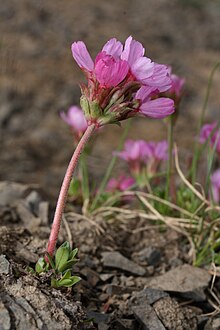| Androsace | |
|---|---|

| |
| Androsace laevigata in Olympic National Park, United States | |
| Scientific classification | |
| Kingdom: | Plantae |
| Clade: | Tracheophytes |
| Clade: | Angiosperms |
| Clade: | Eudicots |
| Clade: | Asterids |
| Order: | Ericales |
| Family: | Primulaceae |
| Subfamily: | Primuloideae |
| Genus: | Androsace L. |
| Sections | |
|
Andraspis
Aizoidium
Pseudoprimula | |

| |
Androsace, commonly known as rock jasmine,[2] is a genus of flowering plants in the family Primulaceae, second only to Primula in the number of species.[3] It is predominantly Arctic–alpine, with many species in the Himalayas (where the genus originated), the mountains of central Asia, the Caucasus, and the southern and central European mountain systems, particularly the Alps and the Pyrenees.
Plants of this genus are sometimes known as rock jasmines or fairy candelabras, and are widely cultivated for their dense cushions covered in white or pink flowers. There are roughly 110 species.[4][5]
These plants have small entire or toothed leaves which form a basal rosette.[6]
- ^ a b Douglasia and Vitaliana were formerly treated as separate genera.
- ^ English Names for Korean Native Plants (PDF). Pocheon: Korea National Arboretum. 2015. p. 352. ISBN 978-89-97450-98-5. Archived from the original (PDF) on 25 May 2017. Retrieved 25 January 2016 – via Korea Forest Service.
- ^ Gerald M. Schneeweiss; Peter Schönswetter; Sylvia Kelso; Harald Niklfeld (2004). "Complex biogeographic patterns in Androsace (Primulaceae) and related genera: evidence from phylogenetic analyses of nuclear internal transcribed spacer and plastid trnL-F sequences". Systematic Biology. 53 (6): 856–876. doi:10.1080/10635150490522566. JSTOR 4135374. PMID 15764556.
- ^ Jepson Manual Treatment
- ^ Flora of China
- ^ Grey-Wilson, Christopher (2001). The Rock Garden Plant Primer. London: Timber Press. p. 47.